Started as an international trade route network, the ancient Silk Road had been developed to be an influential channel of cultural and religious exchanges between the East and the West for over two thousand years. From the east starting point - Chang’an (today’ Xian) to the western countries, many cities were connected by the Silk Road. Although the Silk Routes varied from periods, major cities along it are all located in northern and western China, mainly in Shaanxi, Henan, Gansu, Ningxia, Qinghai and Xinjiang. Beyond the historic significance, these regions happen to have some incredibly amazing natural landscapes of China. To help you find Silk Road travel inspirations, below we select the most popular and recommended China's tourist destinations along the Silk Road based on the original ancient Silk Route.
Major China Silk Road Cities & Destinations
Luoyang, located in Central China’s Henan Province, is a great ancient capital of China of 13 dynasties. It was the capital of China during the Eastern Han Dynasty, which witnessed China’s friendly communications with ancient Rome, and it was the center of the Grand Canal and one of the cradles of Chinese civilization. Luoyang has 6 World Cultural Heritage sites, including Longmen Grottoes (the finest stone carving Buddhist grottoes in China) and other ancient city ruins and sites. When visiting Luoyang, don’t miss the White Horse Temple - the first Buddhist temple in China, which was built after Buddhism was introduced into China in 2 AD and historic ruins of earlier periods. The annual Peony Festival held in spring adds Luoyang a splash of colour. Luoyang is still a popular transfer center to Dengfeng Shaolin Temple for Chinese Kung Fu fans.
Xian is the starting point of the Silk Road and home to the UNESCO World Cultural Heritage - Terracotta Warriors. It once served as the capital of ancient China for 13 dynasties, thus it is voted as one of the Four Greatest Chinese Ancient Capitals and one of the oldest cities in China. With massive historic sites of different dynasties and 6 World Heritage sites, Xian is one of the best representations of Chinese history and culture. There are lots of meaningful things to do in Xian, such as exploring Terracotta Army in Emperor Qinshihuang's Mausoleum Site Museum and other Han Dynasty mausoleums to learn previous craftsmanship and funerary rituals, visiting Ancient City Wall, palaces, towers to appreciate traditional architectures, seeking Buddhist history in Giant Wild Goose Pagoda, enjoying a Tang Dynasty show, experiencing ethnic fusion and trying various local flavors in Muslim Quarter, etc.
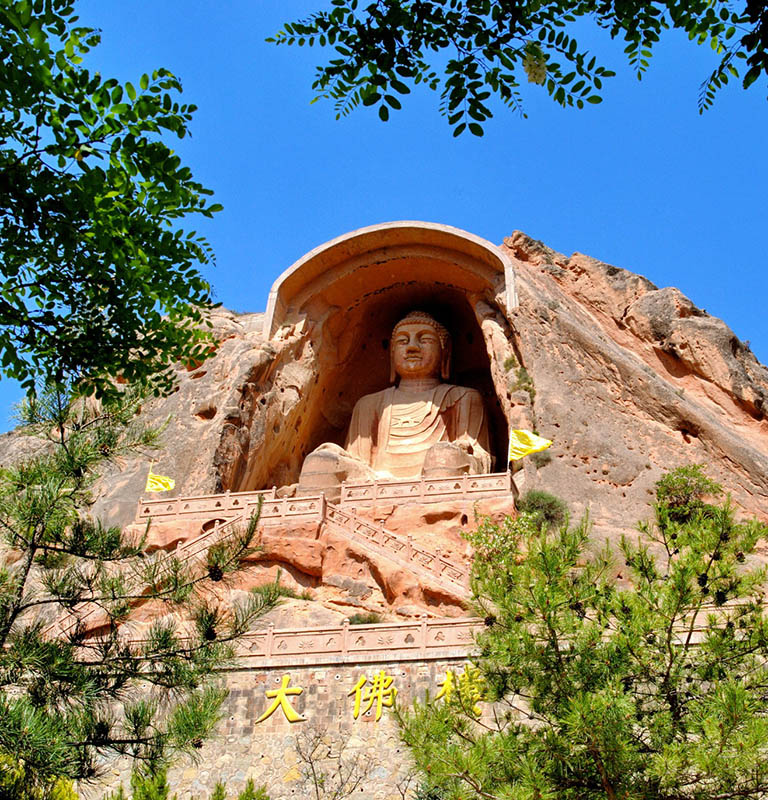
Ningxia, situated inland northwest China between Shaanxi and Gansu, was a must pass on the ancient Silk Road. In the Han and Wei Dynasties, Ningxia’s Guyuan and Zhongwei were important stops. During the Tang Dynasty, Silk Road changed direction and went through Yinchuan, Wuzhong and Zhongwei of Ningxia. In the Yuan Dynasty, a new Silk Route via Guyuan passing Liupanshan Mountain was opened and used until the Qing Dynasty. Ningxia played a very important role in connecting the Central China and Western Regions and the outside world. Many cultural relics preserved can help you explore Ningxia’s history and culture during the Silk Road periods, including the famous Xumishan Grottoes (one of the top 10 grottoes in China with 162 caves and over 500 stone-carved statues), Western Xia Emperors’ Tombs, Guyuan Ancient City, etc. Nature fans should never underrate Ningxia, because it has an interesting and stunning topographic diversity where deserts, rivers, mountains, plains, valleys magically exist in Ningxia.
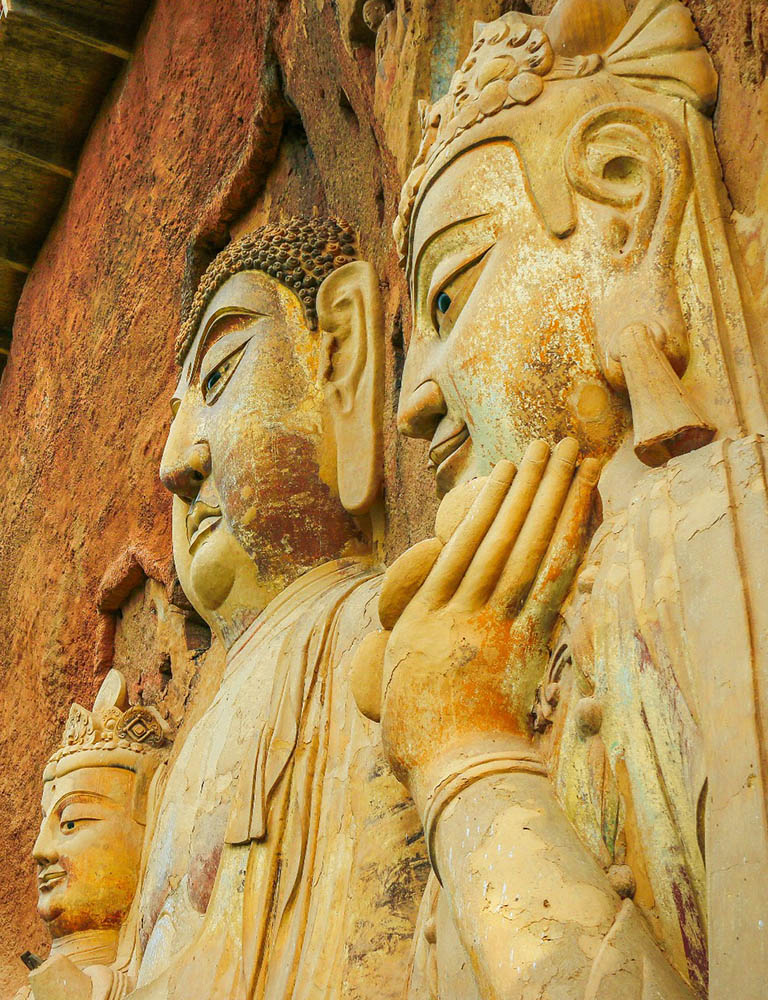
Lying in southeastern Gansu and the middle of Xian and Lanzhou, Tianshui is the geometric center of China and a vital communication hub among Shaanxi, Gansu and Sichuan and the hometown of Fuxi - ancestor of mankind in Chinese mythology. During ancient times, Tianshui served as a crucial pass between Xian and the Hexi Corridor and the Western Regions, a military stronghold and a necessary channel of Buddhism transmission on the Silk Road. The place was a bustling frontier trade center during the Northern Song Dynasty. The previous prosperity and cultural exchanges are well recorded in the exotic Buddhist grottoes and ancient post houses of Tianshui. Maijishan Grottoes, known as “the Oriental Sculpture Gallery” with thousands of exquisite clay sculptures, is an outstanding example of Buddhist grottoes in China, which has been listed as a World Cultural Heritage site. Besides, you can visit Tianshui Museum to see different cultural relics, learn more about Tianshui and visit Fuxi Temple which was built in the Ming Dynasty (late 15th century) to worship the ancient legendary "Fuxi Emperor". Fuxi was very knowledgeable, and created the Eight Diagrams, which made a great progress in Chinese civilization.
Lanzhou has been an important transportation and military town on the Silk Road as well as a significant bond of linking minority groups in the Western Regions since ancient times. Now it’s the gateway to northwest China, especially to Zhangye, Dunhuang and other destinations in Lanzhou. In the Western Han Dynasty of over 2000 years ago, Lanzhou began to play a part in trade and traffic and promotion of the economic and cultural exchange between the East and the West. Lots of following contacts left marks in Lanzhou, such as Ban Chao’s visit to the Western Regions, Tang Sanzang’s Buddhist journey to India, etc. The best place to catch a glimpse of its glorious history and contribution to the Silk Road is the Gansu Provincial Museum in Lanzhou, which exhibits hundreds of cultural relics, like bronze wares, Han & Tang Dynasties silks, Buddhist statues, etc. Meanwhile, the city is the only provincial city China’s mother river - Yellow River flows through. Therefore, you can observe the restless Yellow River, walk through the iconic Iron Bridge to climb up the White Pagoda Mountain, and get a panoramic view of Lanzhou City on either river bank.
Located in western Gansu, middle of Hexi Corridor, northwest China, Zhangye was called Ganzhou long before and is where Gansu gets its name “Gan”. Later, Zhangye was renamed for its location of connecting the Western Regions. Since then, Zhangye has long worked as a vital trade center and strategic thoroughfare on the ancient Silk Road. Nearly all major ancient Silk Road contributors have visited Zhangye when travelling to the west and farther areas, including Zhang Qian, Ban Chao, Monk Fa Xian, Tang Sanzang and Italian traveler - Marco Polo. Top historic sites to explore in Zhangye include Matisi Grottoes - a cliffside Buddhist grottoes remaining splendid Buddhist sculptures of the Western Xia and Yuan Dynasties, Dafo Temple - a famous symbol of Zhangye which has the country’s largest indoor clay reclining Buddha. The most famous emblem of Zhangye nowadays is the colorful Zhangye Danxia - “Rainbow Mountains”, one of the top 10 geological wonders elected by American National Geographic.
Jiayuguan City in northwestern Gansu is the home to the famous Jiayuguan Pass, the westernmost end of the Ming Dynasty Great Wall and the biggest fortress on China’s Great Walls. Jiayuguan City was a very important transport hub on the ancient Silk Road and a busy place where merchants and envoys gathered during the Ming and Qing Dynasties. Jiayuguan Pass stretching in front of the majestic Qilian Mountains is the biggest heritage and highlight of Jiayuguan. The pass was constructed in 1372 during the period of Emperor Hongwu of the Ming Dynasty. With the surrounding beacon towers, abutments, moats and city walls, Jiayuguan Pass had a strict military defense system. During your Jiayuguan tour, visitors can learn the history of the pass and China Great Wall in the Great Wall Museum, hike on a less-known Overhang Great Wall and view the grand Taolaihe Canyon and mysterious brick wall paintings of Wei-Jin Tombs. Popular China Great Wall Tours >>
Dunhuang is world-known for the Mogao Caves, the top of all China’s Buddhist grottoes which gains the title of “Oriental Louvre”. The city, located in the northwest of Gansu, westernmost of Hexi Corridor, used to be the demarcation point of the northern and southern routes of the ancient Silk Road. Therefore, silks and other goods, crops, handicrafts, religions and cultures from ancient China and other countries met and mixed in Dunhuang, making Dunhuang a flourishing border trade and cultural center. That kind of alive scene can be precisely found in the murals in Mogao Caves. As the world’s largest Buddhist art treasury with the richest contents, Mogao Caves is the top must-visit attraction along the ancient Silk Road. You can appreciate time-honored Buddhist sculptures and wall paintings of high artistic value. Yumen Pass and Yangguan Pass are cultural relics of over 2000 years of history. Magical Singing Sands Mountain and the desert oasis - Crescent Spring, Yardang Geopark in Dunhuang shows you supernatural power and beauties.
Most people and travelers know the main Silk Routes from Xian to Hexi Corridor (Zhangye-Jiayuguan-Dunhuang), but very few of them know Qinghai also played an important role in offering a safe and convenient trade route between the East and West during the Wei-Jin Dynasties and late Tang Dynasties. It was said that Zhang Qian returned to Chang’an (Xian) via a little-known path in Qinghai on his first journey. At that time, Xining was the center of Qinghai’s Silk Route which linked neighboring Gansu, Sichuan and Xinjiang. Travelling from Xining to westward areas via Qinghai Lake and Qaidam Basin is the roughest and most dangerous Silk Route within Qinghai. Tourists can partly follow ancient footprints to explore Qinghai, visit Xining’s Kumbum Monastery (Ta’er Monastery) - one of the six greatest Gelug monasteries in China, enjoy beautiful Qinghai Lake, Chaka Salt Lake - Mirror of the Sky, authentic Tibetan Buddhist culture in Tongren, amazing Danxia hills in Kanbula National Forest Park and other plateau landscapes in Qinghai. Taking a sky train trip to the holy land of Tibet from Qinghai is a once-in-a-lifetime experience.
Turpan is a miraculous oasis located in the intermountain Turpan Basin, southern of Tianshan Mountains, eastern Xinjiang. Turpan was the seat of ancient Cheshi Kingdom and Gaochang Kingdom and a crucial pass on the northern route of ancient Silk Road. Products, religions and cultures of different regions once exchanged here via the ancient Silk Route. Turpan’s Jiaohe Ancient City and Gaochang Ancient City, two well-preserved city ruins, have been inscribed as World Cultural Heritage sites of the Silk Road network. Besides, Turpan has Bezklik Thousand Buddha Caves which painted Buddhist murals and royal images of Huihu Gaochang Kingdom. Another lightspot of Turpan is its highest temperature during summer in China, which can be felt in the spectacular fire red Flaming Mountains. Apart from those, you can enjoy desert entertainment in the vast expanding Kumtag Desert, taste sweet and juicy grapes in Grape Valley and learn traditional intelligence of Karez System, a great underground water conservancy project.
Urumqi, which means beautiful pasture in Mongolian, is the capital city and the most important transportation hub in Xinjiang. As the world’s farthest city away from the sea, Urumqi used to be a significant city in the Western Regions on the northern Silk Route. The city has experienced brilliant cultural exchanges from different groups and regions, and the cultural diversity and traditional ethnic customs remain alive in Urumqi. In downtown Urumqi, you can visit Xinjiang Regional Museum to trace back to the ancient Silk Road period, view a large number of cultural relics discovered in Xinjiang and get a quick understanding of the history and culture of Xinjiang areas. Xinjiang International Grand Bazaar is the best place to feel the previous prosperity of international trade culture. Pursue natural beauty in Urumqi? Heavenly Lake of Tianshan Mountains with phenomenal scenery of serene lake, primitive forests and grandiose snowy mountains will surprise you deeply. When summer comes, Nanshan Pasture provides an ideal summer resort and refreshing grassland vision. From Urumqi, it’s easy and convenient to transfer to Kashgar, Kanas, Kucha, Turpan, Hotan, Ili and other major destinations in Xinjiang.
Kucha in ancient times was the Qiuci Kingdom, one of the most powerful states in the Western Regions during the Han Dynasty, and it served as a strategic town on the middle route of ancient Silk Road in Xinjiang. Kucha once owned highly-developed grotto art (much earlier than Dunhuang Mogao Caves), religion, economy and culture. Ancient people of Qiuci were good at music and iron-smelting tech, which had a great influence on other states in the Western Regions. Here has Kizil Caves, the first Buddhist grottoes in China, that preserves some China’s oldest, delicate and unusual murals of ancient Qiuci Kingdom, and two World Cultural Heritage sites - Kizil Gaha Beacon Tower, a military alarm structure of the Han Dynasty and the oldest & best-preserved beacon site on the northern route of the Silk Road, and the Subash Ruins, a major Buddhist temple during the Wei-Jin Dynasties and the largest Buddhist cultural ruin in Xinjiang. With more time, you can visit the Kucha Royal Palace to appreciate integrated architectural styles of traditional Chinese and Islamic and the magnificent Tianshan Mysterious Grand Canyon.
Hotan, situated in the south of Taklamakan Desert and Tarim Basin, west of Kashgar, was the starting point of the Jade Road, first stop of Buddhism’s transmission and a vital town on the southern route of the ancient Silk Road. Hotan once was the Yutian Kingdom, a very strong state on the southern Silk Route, which had developed agriculture, crop production and manual textile industry, and the earliest silkworms raising technique in China. After Buddhism was introduced into China in the late 2nd century, Hotan had long been the center of Mahayana Buddhism.
Through the ancient Silk Road, many western travelers and merchants gathered in Hotan, brought different goods and cultures, which later shaped the mixed musics, operas, paintings, art and folk customs of Hotan with some Indian and Iranian styles. History left massive cultural relics and city ruins in Hotan. Niya Ruins is the most famous and mysterious one, it is a large ruins composed of tombs, houses, temples, farmlands and other functional zones between the 1st century BC to 4th century. Unearthed cultural relics are extremely rich covering different types, textiles excavated are rare and valuable. In central Hotan city, you can learn more history from the Hotan Museum. Now Hotan is most known for Hotan Jade, hand-made carpet and Adilis Silk. To arrive in Hotan, a scenic road trop via the wild Taklamakan Desert is highly recommended.
Kashgar in southwestern Xinjiang has been an important frontier trade and cultural center and gateway to Central & West Asia for over 2 millenniums years. Historically, Kashgar was the seat of many ancient kingdoms. Among them, the Shule Kingdom and the Shache Kingdom were two main regimes. Just then, Kashgar was a center where the middle and south routes of ancient Silk Road converged, therefore, grew rapidly as an international trade port attracting numerous Eastern and Western merchants. Today, Kashgar is the only national-level historical and cultural city in Xinjiang which exhibits the essence of Uyghur folk customs, art, architecture and diverse cultures. There are lots of places to explore the abundant cultures of Kashgar, such as the “Living Memory of the Silk Road” - over 2000-year-old Kashgar Old Town (the world’s largest earthen building complex), Kashgar Bazzar - Asian largest bazaar, Sunday Livestock Market - Xinjiang’s biggest livestock market, Id Kah Mosque - the largest mosque in China, etc. Moreover, Kashgar is the transfer center in Southern Xinjiang, and travelers can get from Kashgar to Tashkurgan via Karakul Lake on the Karakoram Highway, view stunning Pamirs landscape, and travel to Hotan, Kucha and Shache.
Major Destinations to Go: Xian, Luoyang, Dunhuang, Zhangye, Jiayuguan, Lanzhou, Qinghai, Urumqi, Turpan, Kashgar, Kucha, Hotan, Tianshui, Ningxia...
Top Tourist Attractions to Visit: Xian Terracotta Warriors, Dunhuang Mogao Caves, Zhangye Danxia Landform - Rainbow Mountains, Qinghai Lake, Heavenly Lake, Jiaohe Ancient City, Kashgar Old Town, Karakul Lake...
Best Time to Go: Generally, months from April to October are the best time, because the temperature is moderate and pleasant, the weather is good and the natural scenery is the most beautiful during this period.
The ancient Silk Road is a long tourist travel route involving lots of Chinese destinations, mostly located in Northwest China. A Silk Road travel can be flexibly customized according to travelers’ length of vacations, departure city, individual preferences and budget. It can take a few days to a few weeks and months.
If you have a tight schedule with only several days (4 ~ 5 days), you’re advised to make a brief Silk Road tour from the starting point - Xian, and visit Luoyang nearby or Dunhuang, the legendary treasury of Buddhist art, history and culture. If you have visited Xian and would like a deeper exploration, then Gansu’s Hexi Corridor (Zhangye, Jiayuguan and Dunhuang) - essence of ancient Silk Road is the best recommendation and a classic trip takes about 6 days.
☛ 6 Days Zhangye Jiayuguan Dunhuang Discovery Tour
☛ 5 Days Silk Road Tour from Xian to Dunhuang by Flight
☛ 5 Days Luoyang Xian Tour by Train
Travelers with 7 ~ 8 days can visit more Silk Road destinations. You can explore the Hexi Corridor with neighboring Qinghai, enjoy beautiful Qinghai Lake and other stunning landscapes and cultures, or travel farther to Xinjiang, unveil the mysterious Western Regions in top destinations - Turpan, Urumqi and Kashgar. Depending on your pace, you can even take some side trips, such as travelling to Karakul Lake from Kashgar.
☛ 7 Days Miraculous Land Tour from Dunhuang to Zhangye Xining
☛ 8 Days Classic Xinjiang Tour including Urumqi Turpan Kashgar Tashkurgan
A holiday of 10 ~ 15 days and a longer length is suitable to cover major destinations along the Silk Road in China. You can flexibly arrange an itinerary based on your interests. The most classic Silk Road tour covers Xian, main destinations in Hexi Corridor and Xinjiang, and takes just 10 days. Qinghai and Ningxia are popular regions for an in-depth Silk Road adventure. If time allows, you can visit the holy land of Tibet (Lhasa, Shigatse, Mount Everest, Mt.Kailash...) which has impressive Buddhist and Tibetan culture and plateau vista, and other destinations in China to experience the vast and diversity of China.
☛ 10 Days Classic Silk Road Tour (Xian/Dunhuang/Turpan/Kashgar)
☛ 11 Days In-depth Wild Silk Road Adventure Tour
☛ 12 Days Epic Silk Road Tour including Qinghai Lake and Zhangye Danxia
☛ 15 Days Classic Ancient China Silk Road Tour with Bullet Train Experience
☛ 19 Days Silk Road & Tibet In-depth Tour
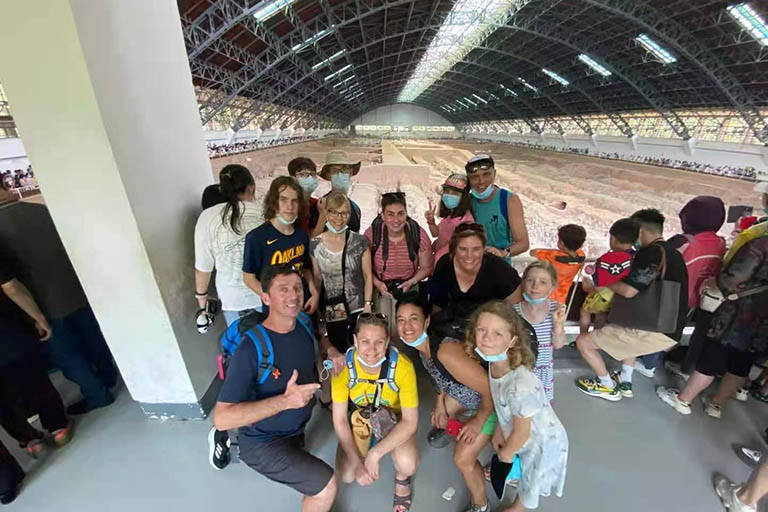 Our customers Cameron Family from New Zealand visited Terracotta Warriors in Xian in July, 2021.
Our customers Cameron Family from New Zealand visited Terracotta Warriors in Xian in July, 2021.
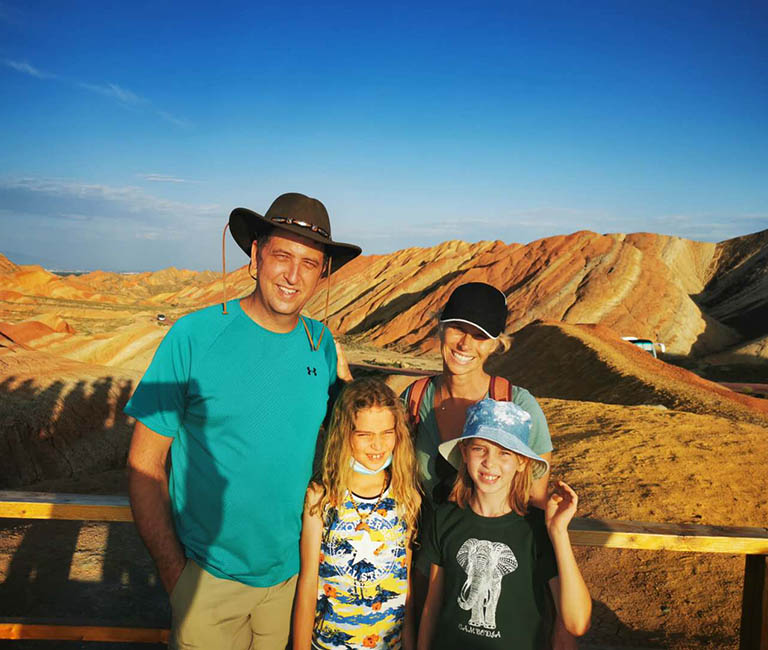 Our customers Erin family from USA visited Zhangye Danxia Geopark in Gansu in August, 2020.
Our customers Erin family from USA visited Zhangye Danxia Geopark in Gansu in August, 2020.
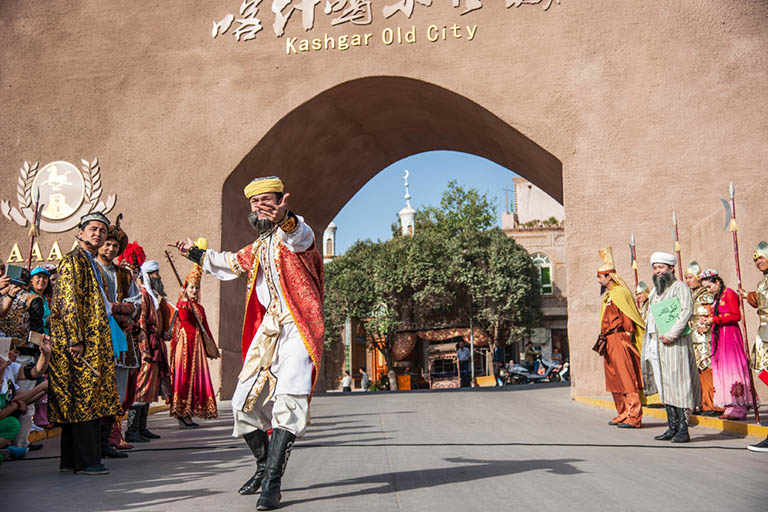 Kashgar Old Town ©骆小洛的世界 / mafengwo
Kashgar Old Town ©骆小洛的世界 / mafengwo
Since most destinations along the ancient Silk Road are located in the remote Northwest China and some attractions are scattered far from the cities, it’s best to travel with a local professional travel agency, like China Discovery, to enjoy a Silk Road adventure. We will not only help you plan a suitable travel itinerary, but also arrange all the services you need, including tour guides and drivers, transfer vehicles, hotels and tickets, meals, etc., to make sure you make an educational cultural and historical travel with relaxing visual enjoyment. You can find more inspiration from our Most Popular China Silk Road Tours or contact us to customize a special one.